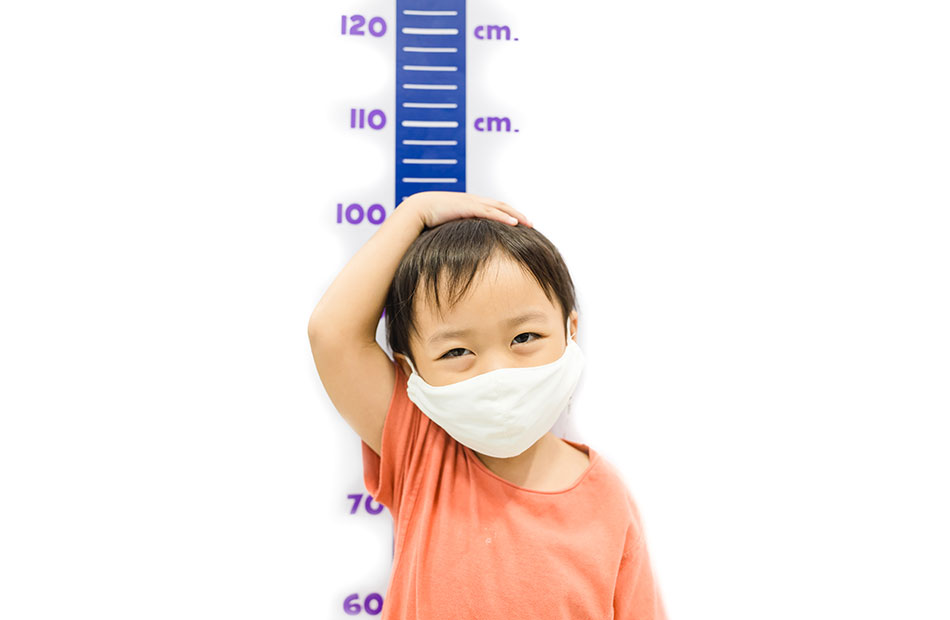Table of contents
The height of a child from birth to adulthood is determined by many factors: genetics, nutrition, exercise and disease. As soon as it is discovered that a child’s height is abnormal for their age, in addition to encouraging their child to be physically active and bringing them to a nutritionist and paediatrician for consultation, parents should take their child to see a paediatric endocrinologist to ensure timely treatment can be administered with the “golden period” prior to puberty if the child is diagnosed with growth hormone deficiency.
Screening and diagnosis of growth hormone deficiency in children
In order to determine if a child has a growth hormone deficiency which is causing growth retardation, the child needs to be intensively evaluated by a paediatric endocrinologist.

Step 1: Clinical examination
An endocrinologist will examine your child to look for signs of a growth hormone deficiency. Subsequently, more tests and imaging might be assigned, such as X-ray of the left hand to assess bone age, basic blood tests to determine blood count, liver and kidney function, screening for levels of vitamin D and calcium, analysis of alkaline phosphatase bone metabolism, and chromatograms in girls.
Step 2: Perform an exercise test to screen for growth hormone deficiency
The total time to perform the test is around 40 minutes. The child will run on a rolling mat for 20 minutes under the supervision of a nurse to achieve the necessary vital signs. During this time, the child will have blood drawn three times via painless vacuum at zero, 20, and 40 minutes to measure growth hormone levels.
If the results of quantitative growth hormone testing after exercise are normal, then growth hormone deficiency disease is excluded. If results suggest a growth hormone deficiency, the child will proceed to the next stage.
Step 3: Perform stimulation test with glucagon or insulin to screen for growth hormone deficiency
This test takes between two and three hours to perform, always under the supervision of a doctor and a nurse. The child has blood drawn from six to eight times through a pre-set intravenous line to measure growth hormone levels. The results of quantitative growth hormone after this test will help determine whether or not the child has growth hormone deficiency.
Step 4: MRI of the pituitary gland to determine the cause of growth hormone deficiency (if results were confirmed in Step 3)
Up to 90 per cent of children with growth hormone deficiency have normal pituitary MRI results and are concluded to have simple idiopathic growth hormone deficiency.
Treatment of growth hormone deficiency in children at FV Hospital
Currently, there is only one method of treating growth hormone deficiency which has been approved by the FDA for the past 30 years: subcutaneous growth hormone injection. Growth hormone must be refrigerated between two and eight degrees Celsius, and the injection time is usually fixed at 21 to 22 hours for the drug to work best when the child is sleeping. The amount of growth hormone will be calculated separately for the child during the treatment period according to the regimen. Parents will be provided with the means of taking the medicine together with specific instructions on how to use it, as well as the dosage.

Subcutaneous growth hormone injection is carried out simply and conveniently at home under the guidance of a doctor.
If the child is diagnosed with simple idiopathic growth hormone deficiency, the aim of treatment will be to increase the height of the child, the success rate for which is almost 100 per cent. However, for cases with multi-axis pituitary damage and other causes, the treatment goals will vary from case to case and assessment of success will be individualised on a case-by-case basis.
According to Dr Nguyen Thi Thu Huong at the Endocrinology Unit, Department of Internal Medicine, FV, there is no general treatment time for this disease, and care protocols vary for each patient. Children should be evaluated and treated as soon as possible once their score is diagnosed, and preferably before the time of complete puberty, or before the skeletal age of the left hand has reached 14 to 16 years, respectively. If the treatment regimen if followed correctly and the patient is responsive, they will achieve their optimum genetic height at the time of adulthood. Usually, an improvement in the patient’s height increase rate is seen within the first three months of treatment.
During the first two weeks of treatment, your child may experience side effects such as joint pain and headache, but these are benign and will stop in due course. In the long term, the injection of growth hormone does not cause adverse effects on the health and intelligence of the child.

With more than 10 years of experience in the field of endocrinology, Dr Thu Huong is known as a person with high expertise in the treatment of diseases such as diabetes, gonadal disorders and disorders of thyroid, adrenal and pituiary glands. For many years Dr Thu Huong is passionate and has continuously pursued Paediatric Endocrinology, especially the diagnosis and treatment of growth hormone (GH) deficiency. With expertise and dedication, Dr Thu Huong has successfully treated many cases and received the love and trust from patients.
To book an appointment with Dr Nguyen Thi Thu Huong, Endocrinology Unit, Department of Internal Medicine, please contact: 028 35 11 33 33.
This content belongs to the growth hormone deficiency in children awareness campaign of FV Hospital in collaboration with Novo Nordisk
Source: Sức khỏe đời sống



